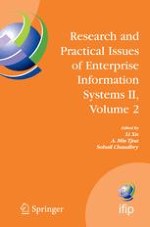Enterprise information systems (EIS) have become increasingly popular over the last 15 years [1-2]. EIS integrate and support business processes across functional boundaries in a supply chain environment [3-5]. In recent years, more and more enterprises world-wide have adopted EIS such as Enterprise Resource Planning (ERP) for running their businesses. Previously, information systems such as CAD, CAM, MRPn and CRM were widely used for partial functional integration within a business organization. With global operation, global supply chain, and fierce competition in place, Acre is a need for suitable EIS such as ERP, E- Business or E-Commerce systems to integrate extended enterprises in a supply chain environment with the objective of achieving efficiency, competency, and competitiveness. As an example, the global economy has forced business enterprises such as Dell and Microsoft to adopt ERP in order to take the advantage of strategic alliances within a global supply chain environment. Today, not only the large companies, but also the medium companies are quickly learning that a highly integrated EIS is more and more a required element of doing business. Businesses all over the world are investing bilhons of doUars in acquiring and implementing EIS in particular ERP systems by SAP and Oracle. As a result, there is a growing demand for researching EIS to provide insights into challenges, issues, and solutions related to the design, implementation and management of EIS.
